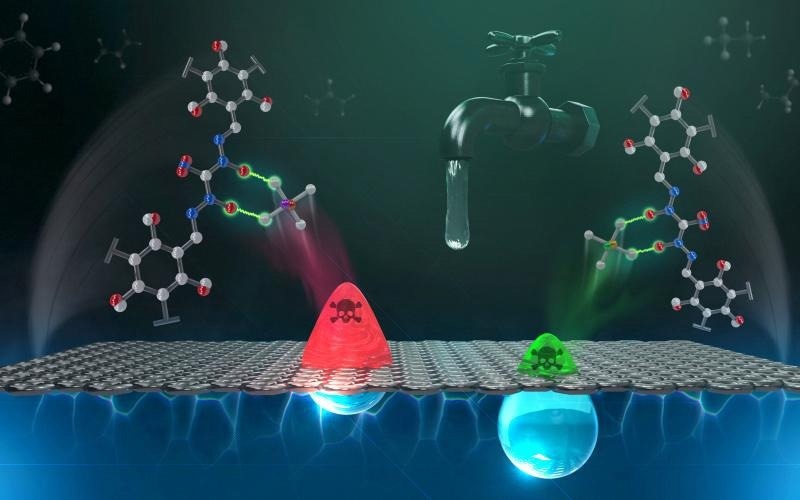At the Department of Energy’s Oak Ridge National Laboratory (ORNL), scientists are handling a global water challenge with a special material that has been specifically developed for the concurrent removal of two deadly and heavy metal pollutants from water.
 Researchers at Oak Ridge National Laboratory designed an adsorbent material to rapidly remove toxic chromium and arsenic simultaneously from water resources. Image Credit: Adam Malin/ORNL, US Dept. of Energy.
Researchers at Oak Ridge National Laboratory designed an adsorbent material to rapidly remove toxic chromium and arsenic simultaneously from water resources. Image Credit: Adam Malin/ORNL, US Dept. of Energy.
Santa Jansone-Popova of the Chemical Sciences Division from ORNL and Ping Li, currently at Elementis Global, have found that an adsorbent with high selectivity for arsenic and chromium in real conditions where water resources consist of several chemically similar elements.
The outcomes of the study reported in the journal Small have illustrated that the new material has the potential to capture arsenic and chromium in a balanced 2-to-1 ratio. The basic advance is responsible for the making of synergy between arsenic and chromium capture so that the more chromium the material grabs, the more arsenic it can also remove.
It is rare for an adsorbent to capture two pollutants simultaneously, and to work quickly and efficiently in realistic scenarios to address the broad range of water conditions worldwide.
Santa Jansone-Popova, Chemical Sciences Division, Oak Ridge National Laboratory
Throughout the world, arsenic and chromium are two of the most harmful pollutants found in drinking water; both are poisonous and can result in detrimental health effects, such as cancer.
Even low levels can pose considerable threats to living organisms as it doses bioaccumulate and can gradually reach harmful amounts.
These elements occur naturally, but their presence in the environment has increased with industry and urbanization as byproducts of broad mining, production, and manufacturing. Discharges impact air, soil, and water, but drinking water is known as the most general route of exposure.
As far as water is concerned, such metals dissolve to develop arsenate and chromate oxoanions, or salts, that are chemically similar to advantageous minerals that are present naturally in water, such as sulfate, phosphate, bicarbonate, and nitrate. Arsenate and chromate are highly mobile in water and possess far-reaching impacts.
They do not degrade and are permanent in the surrounding without interference. Targeted methods are required to isolate such metals from detrimental mineral salts that are crucial to the ecosystem.
Jansone-Popova is part of an ORNL group that specializes in the study of adsorbents and materials that are developed to target specific elements and fasten them to a surface. Adsorbents have extensive applications in the recovery of valuable metals or eliminating pollutants from the surrounding.
They are one of the most promising water treatment options because they are affordable, easily deployed and can work quickly to filter water supplies, but they need to be tailored for practical use in cleanup scenarios.
Santa Jansone-Popova, Chemical Sciences Division, Oak Ridge National Laboratory
Jansone-Popova added, “The challenge is to design materials that can effectively isolate trace amounts of harmful elements that are very similar to the bulk chemical species found in water.”
Selectivity is key as far as the adsorbent design is concerned. Since the surface of the material provides limited real estate, the aim is to grab only the targeted elements and capture as much as possible before the adsorbent fills up and needs to be recycled or replaced.
Poorly selective materials fall short of the accuracy to single out targets in mixed surroundings, like water, where similar elements contend for space.
Earlier, Jansone-Popova headed the design of an adsorbent with high selectivity for chromate that functions quickly and in the existence of rival species to decontaminate water.
A study reported in the journal Environmental Science and Technology displayed that the novel material helped reduce the concentrations of chromate 100-fold within a minute (1 part per million to 10 parts per billion) and achieved a level of an order of magnitude below permissible limits fixed by the US Environmental Protection Agency.
The collaboration with Ping Li builds on the current method with the hope of establishing a framework for capturing both arsenate and chromate with just one material.
Li stated, “Our starting material is highly effective at capturing chromium in its most toxic form, hexavalent chromium, but the approach was not designed to be selective for arsenic. As this reaction happens, however, the material changes, creating a platform for new chemistries.”
Scientists altered the original structure to decrease captured chromium-6 into a less poisonous state, chromium-3. Also, chromium-3 has the advantage of offering an anchor point to bind arsenate. The new structure allows a chemical reaction that develops stable chromate–arsenate clusters that are powerfully bonded to the surface.
The outcome efficiently traps the toxins in a permanent manner as they will not wash off or separate from the filter material in the absence of intentional removal by chemical processing.
“We leveraged the efficient capture of hexavalent chromium to introduce a new architecture that could also bind with arsenic,” stated Li.
Chromate arsenate, once utilized as an additive in pressure-treated lumber, offered inspiration for the structure.
The group has patented the structure and is working alongside collaborators to extend the method to other environmental pollutants.
Fundamental discoveries like these can help us reduce toxic pollutants in the environment and meet regulatory goals for clean water.
Santa Jansone-Popova, Chemical Sciences Division, Oak Ridge National Laboratory
This study was financially supported by the Office of Science and used resources of the Compute and Data Environment for Science at ORNL.
Journal Reference:
Li, P., et al. (2022) Bifunctional Ionic Covalent Organic Networks for Enhanced Simultaneous Removal of Chromium(VI) and Arsenic(V) Oxoanions via Synergetic Ion Exchange and Redox Process. Small. doi.org/10.1002/smll.202104703.